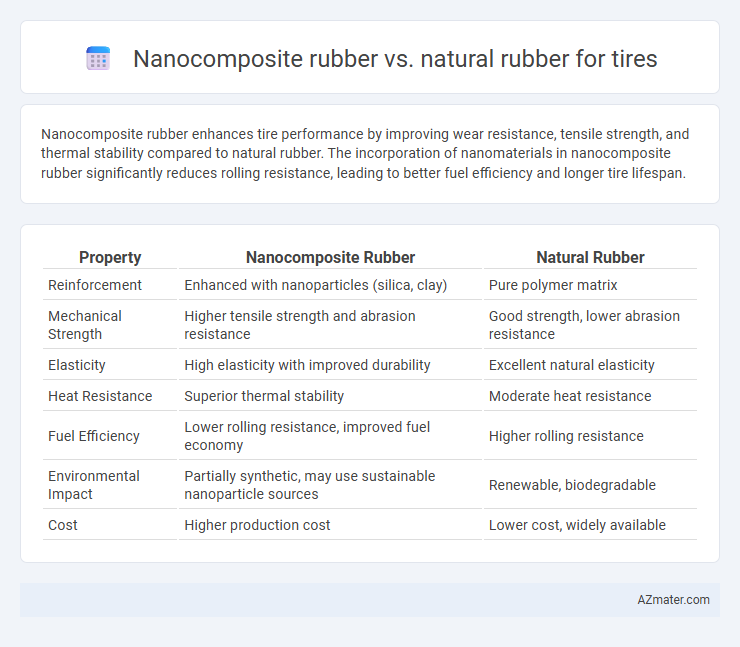Nanocomposite rubber enhances tire performance by improving wear resistance, tensile strength, and thermal stability compared to natural rubber. The incorporation of nanomaterials in nanocomposite rubber significantly reduces rolling resistance, leading to better fuel efficiency and longer tire lifespan.
Table of Comparison
| Property | Nanocomposite Rubber | Natural Rubber |
|---|---|---|
| Reinforcement | Enhanced with nanoparticles (silica, clay) | Pure polymer matrix |
| Mechanical Strength | Higher tensile strength and abrasion resistance | Good strength, lower abrasion resistance |
| Elasticity | High elasticity with improved durability | Excellent natural elasticity |
| Heat Resistance | Superior thermal stability | Moderate heat resistance |
| Fuel Efficiency | Lower rolling resistance, improved fuel economy | Higher rolling resistance |
| Environmental Impact | Partially synthetic, may use sustainable nanoparticle sources | Renewable, biodegradable |
| Cost | Higher production cost | Lower cost, widely available |
Introduction to Tire Materials: Nanocomposite Rubber vs Natural Rubber
Nanocomposite rubber integrates nanoscale fillers such as silica or carbon nanotubes into the polymer matrix, significantly enhancing tire performance through improved tensile strength, abrasion resistance, and thermal stability compared to natural rubber. Natural rubber, derived from Hevea brasiliensis latex, offers excellent elasticity and resilience but lacks the advanced mechanical and durability properties provided by nanocomposite formulations. The incorporation of nanocomposites in tire manufacturing represents a strategic advancement to optimize rolling resistance, wet traction, and overall tire lifespan beyond the capabilities of conventional natural rubber.
Composition and Structure: Comparing Nanocomposite and Natural Rubber
Nanocomposite rubber incorporates nanoscale fillers like silica or carbon nanotubes dispersed within the polymer matrix, enhancing mechanical strength, abrasion resistance, and thermal stability compared to natural rubber. Natural rubber is primarily composed of cis-1,4-polyisoprene with limited intrinsic reinforcement, leading to lower tensile strength and durability under high stress conditions. The nanocomposite structure creates a more uniform filler distribution and stronger polymer-filler interactions, resulting in superior performance characteristics ideal for advanced tire applications.
Mechanical Properties: Strength, Flexibility, and Durability
Nanocomposite rubber in tires exhibits enhanced mechanical properties compared to natural rubber, offering superior tensile strength and improved abrasion resistance due to the incorporation of nanoparticles like silica or carbon nanotubes. This advanced material maintains excellent flexibility, allowing better deformation under stress while preserving structural integrity, which contributes to longer tire lifespan and improved performance. The enhanced durability of nanocomposite rubber results from its ability to resist wear, tear, and environmental degradation, making it a preferred choice for high-performance and long-lasting tires.
Wear Resistance and Longevity in Tire Performance
Nanocomposite rubber exhibits significantly enhanced wear resistance compared to natural rubber due to the uniform dispersion of nanoparticles such as silica or carbon nanotubes, which reinforce the rubber matrix and reduce abrasion. This improvement in wear resistance directly translates to increased tire longevity, as nanocomposite tires maintain tread integrity over longer distances and harsh driving conditions. The combination of superior mechanical strength and reduced degradation mechanisms enables nanocomposite rubber tires to outperform natural rubber in durability and lifespan.
Rolling Resistance and Fuel Efficiency Impact
Nanocomposite rubber exhibits significantly lower rolling resistance compared to natural rubber, resulting in enhanced fuel efficiency for tires. The incorporation of nanoparticles improves the tire's deformation properties, reducing energy loss during rotation and thereby lowering fuel consumption. This advancement makes nanocomposite rubber a superior choice for eco-friendly and cost-efficient tire performance.
Environmental and Sustainability Considerations
Nanocomposite rubber exhibits enhanced durability and reduced rolling resistance compared to natural rubber, leading to extended tire lifespan and improved fuel efficiency, which lowers greenhouse gas emissions. The incorporation of nanoscale fillers in rubber matrices reduces raw material consumption, promoting resource efficiency and minimizing environmental impact. However, natural rubber remains biodegradable and sourced from renewable resources, offering advantages in end-of-life tire disposal and ecosystem sustainability.
Cost Analysis: Production and Lifecycle Expenses
Nanocomposite rubber offers enhanced durability and improved wear resistance compared to natural rubber, resulting in longer tire lifespan that reduces replacement frequency and overall lifecycle expenses. Production costs for nanocomposite rubber tend to be higher due to the incorporation of advanced nanomaterials and more complex manufacturing processes, but these upfront investments are offset by lower maintenance and better fuel efficiency. In contrast, natural rubber features lower initial production costs but incurs higher long-term expenses related to faster degradation and increased tire replacements.
Innovation and Technological Advancements in Tire Materials
Nanocomposite rubber incorporates nanoscale fillers such as carbon nanotubes and silica, enhancing tire performance through improved wear resistance, traction, and fuel efficiency compared to traditional natural rubber. Technological advancements in dispersion techniques and polymer-filler interactions have enabled precise control over nanocomposite structures, resulting in tires with superior durability and reduced rolling resistance. These innovations drive the automotive industry's shift toward high-performance, sustainable tire materials by optimizing mechanical properties and extending tire lifespan.
Safety and Traction: Road Performance Evaluation
Nanocomposite rubber enhances tire safety and traction by integrating nanoparticles like silica or carbon nanotubes, which improve grip and wear resistance on wet and dry surfaces compared to natural rubber. This advanced material offers superior road performance through better heat dissipation and reduced rolling resistance, leading to increased stability and control during cornering and braking. Studies show nanocomposite tires exhibit higher traction coefficients and shorter stopping distances, crucial for high-speed and all-weather driving conditions.
Future Prospects: Trends in Rubber Material Selection for Tires
Nanocomposite rubber exhibits enhanced mechanical strength, thermal stability, and wear resistance compared to natural rubber, positioning it as a leading candidate for next-generation tire materials. Innovations in nanotechnology enable the incorporation of silica nanoparticles and carbon nanotubes to improve fuel efficiency and durability, aligning with stricter environmental regulations and sustainability goals. The future of tire manufacturing is trending towards hybrid composites that blend natural rubber's elasticity with nanocomposite's superior performance characteristics to meet evolving industry demands.

Infographic: Nanocomposite rubber vs Natural rubber for Tire
 azmater.com
azmater.com